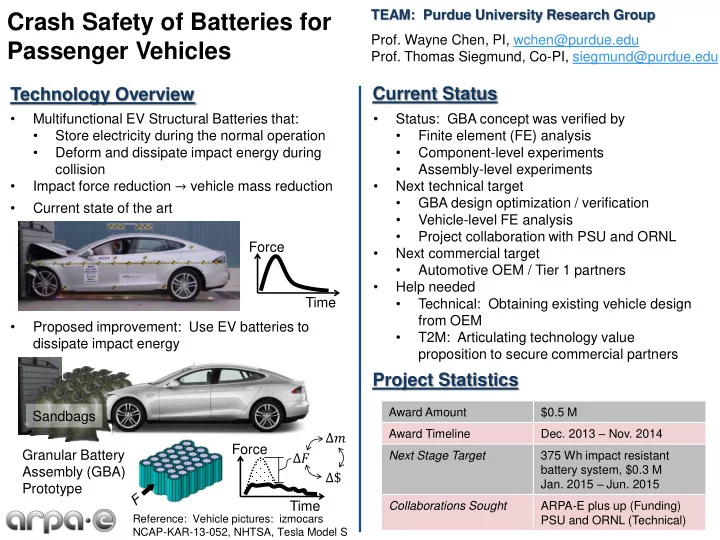

TEAM: Purdue University Research Group Crash Safety of Batteries for Prof. Wayne Chen, PI, wchen@purdue.edu Passenger Vehicles Prof. Thomas Siegmund, Co-PI, siegmund@purdue.edu Current Status Technology Overview • • Multifunctional EV Structural Batteries that: Status: GBA concept was verified by • • Store electricity during the normal operation Finite element (FE) analysis • • Deform and dissipate impact energy during Component-level experiments • collision Assembly-level experiments Impact force reduction → vehicle mass reduction • • Next technical target • GBA design optimization / verification • Current state of the art • Vehicle-level FE analysis • Project collaboration with PSU and ORNL Force • Next commercial target • Automotive OEM / Tier 1 partners • Help needed • Time Technical: Obtaining existing vehicle design from OEM • Proposed improvement: Use EV batteries to • T2M: Articulating technology value dissipate impact energy proposition to secure commercial partners Project Statistics Award Amount $0.5 M Sandbags Dec. 2013 – Nov. 2014 Award Timeline ∆𝑛 Force Granular Battery ∆𝐺 Next Stage Target 375 Wh impact resistant battery system, $0.3 M Assembly (GBA) ∆$ Jan. 2015 – Jun. 2015 Prototype Time Collaborations Sought ARPA-E plus up (Funding) Reference: Vehicle pictures: izmocars PSU and ORNL (Technical) NCAP-KAR-13-052, NHTSA, Tesla Model S
Finite Element Analysis Simplified Model Full Model Ratio: [Battery:Tube] Effects of sacrificing cell materials and coefficient of friction on GBA [0:25] [4:21] [8:17] 500 Al 6061, = 0.15 Al 6061, = 0.35 400 Al 6061, = 0.55 Al 6061, = 0.75 Force (kN) 300 SS 304, = 0.15 SS 304, = 0.35 200 SS 304, = 0.55 SS 304, = 0.75 [13:12] [25:0] 100 Simplified Full 0 0 10 20 30 40 50 60 Displacement (mm) 𝑢 𝐵𝑚 6061 = 0.51 mm; 𝑢 𝑇𝑇 304 = 0.13 mm Component Model 18650 LiFePO4 Cell by A123 120 50 0:25 Exp., SOC = 1:8% 100 40 4:21 Force (kN) Force (kN) Exp., SOC = 10:0% 80 Fracture 8:17 Finite Element Model 30 60 13:12 20 40 25:0 20 10 0 0 0 2 4 6 8 10 0 10 20 30 40 50 60 Displacement (mm) Displacement (mm) Reference: Battery cell constitutive model: Sahraei, Campbell, & Wierzbicki (2012) 2
Impact Energy Dissipation Demonstration Component Assembly Research Showcase Level Level Loading Type Demon- Demon- Sacrificing stration stration Battery Cells GBA Tubes MTS Quasi-static Yes Yes Yes Yes - Drop Tower Dynamic Yes Yes Yes Yes - Yes Suitcase Dynamic - - (Reduced - Yes capacity) Drop Load Cell Load Winch Mass Connection Cell Loading Specimen Direction Load Loading Upper Cell Wall Direction Fixture Tup Bottom Specimen Support Loading Direction Lower Specimen Springs Fixture MTS Machine Drop Tower Impactor Suitcase Portable Impactor 3
Component-level Analysis Dynamic Study Quasi-static Study Al Al Glass 𝜁 = 10 1 /𝑡 𝜁 = 10 −1 /𝑡 t = 0.51 𝑛𝑛 t = 1.24 𝑛𝑛 t = 1.14 𝑛𝑛 ( 𝑤 = 182 𝑛𝑛/𝑡 ) ( 𝑤 = 1.82 𝑛𝑛/𝑡 ) Mass: 7.3 𝑙 ; Velocity: 2.0 𝑛/𝑡 ; Energy 14.6 𝐾 70 15 0 = 10 ! 3 =s 1.5 Force (kN) Al, t = 0.51 mm _ State of charge (SOC) = 10% 60 0 = 10 ! 2 =s Al, t = 0.89 mm _ Al, t = 1.24 mm 0 = 10 ! 1 =s _ 50 0 Al, t = 1.47 mm 10 0 0.5 0 = 10 1 =s Force (kN) _ Force (kN) Al, t = 1.65 mm Displacement (mm) 40 Glass, t = 1.14 mm 30 5 20 10 0 0 0 2 4 6 8 10 0 2 4 6 8 10 Displacement (mm) Displacement (mm) See top right In addition to the above study, the following experiments were also performed: 1) Sacrificing tubes under quasi-static line loading, 2) sacrificing tubes under dynamic line loading, 3) battery cells under dynamic line loading, and 4) battery cells under point loading. 4
Assembly-level Analysis GBA vs. Base Preliminary Study: Sacrificing Foams Velocity Velocity GBA Base 2.5 𝑛/𝑡 3.0 𝑛/𝑡 Low High Mass Low- Low- 11.7 𝑙 Low High (36.5 𝐾 ) (52.6 𝐾 ) Low Mass High- High- 16.7 𝑙 Low High (52.2 𝐾 ) (75.1 𝐾 ) High Mass: 27.5 𝑙 ; Velocity: 5.0 𝑛/𝑡 ; Energy: 343.7 𝐾 10 40 Base Low-Low Low-High 32.8% reduction GBA 30 Force (kN) Force (kN) High-Low High-High 5 20 10 0 0 0 5 10 15 20 25 30 35 0 5 10 15 20 25 30 35 Displacement (mm) Displacement (mm) Performance of this particular GBA system was worse Preliminary setup with sacrificing foams enabled than expected. To improve the performance, friction multiple hits without replacements. properties and strength of sacrificing cells will need to be optimized. 5
Effects of Peak Force ( 𝒍𝑶 ) Reduction on Vehicle Weight ( 𝒍𝒉 ) and Price ( $ ) - Maximum Impact Force Analysis (Left) and Purchase Price Analysis (Right) with respect to vehicle weight 1,000 45,000 Max Impact Force (kN) Vehicle Price ($) 800 35,000 600 25,000 400 15,000 200 5,000 1,000 1,500 2,000 1,000 1,500 2,000 Vehicle Weight (kg) Vehicle Weight (kg) Impact force reduction → Vehicle weight reduction → Vehicle price reduction - Example: Assuming linear scale up from the prototype to full vehicle Impact Force ( 𝑙𝑂 ) Vehicle Weight ( 𝑙 ) Vehicle Price ($) 750 1,846 36,696 504 1,173 13,645 ∆ Impact Force = 246 kN ∆ Vehicle Weight = 673 kg ∆ Vehicle Price = $23,051 (32.8% reduction) (36.4% reduction) (62.8% reduction) 6
Recommend
More recommend